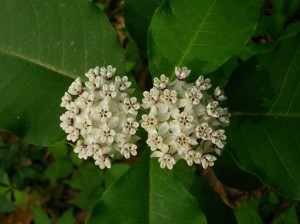I BREAK FOR BUTTERFLYS should be on the bumper of my car. I love these beautiful creatures.
This year, in the garden, I attribute them as the pollinators of my green beans. They are little yellow butterflys, no bigger than a moth. I don’t know their name and they are too fast to take a picture of.
I was recently reading an issue of Country Gardens magazine (summer 2012) and discovered an article called “Of Milkweed and Monarchs, Plant milkweed to help pollinators: Monarch larvae depend on it for their survival.” by Anne Raver. I was astounded by the news I read which explained how important milkweed is to the Monarch butterfly and how the population has dwindled over the years. The article is too long for me type and I couldn’t find it online, so here some excerpts from the article.

“Common milkweed and it’s cousins, swamp milkweed, and butterfly weed, to name a few in the milkweed family, are crucial to the Monarch butterfly. The female lays her eggs on the underside of a milkweed leaf, and the larvae feast on the leaves. Milkweed is the only food these caterpillars eat, though the adult butterflys will sip nectar from many flowers. And so, if milkweed disappears from the face of the Earth – destroyed by herbicides, mainly – so, too, will the beautiful black, orange, and white Monarch butterfly.”
“The main culprit, scientists say, is Roundup, or glyphosate, the popular herbicide farmers spray on million of acres of soybeans and corn that have been genetically modified to tolerate the weed killer. According to Chip Taylor, Ph.D., a professor of insect ecology at The University of Kansas and director of Monarch Watch (monarchwatch,org), milkweed has disappeared from 100 million acres of corn and beans grown in the middle of the United States. These fields, which used to be dotted with milkweed and other familiar weeds such as chicory and Queen’s Anne’s lace, are in the Monarch butterfly’s migration path.
Monarchs, of course, are the heroic butterflies that can fly as far as 2,000 miles from their northernmost range in the eastern provinces of Canada, down through South Dakota and Texas, on their way to the Transvolcanic Range of centeral Mexico, where they cluster by the million in the oyamel fir forests.”
“Since the 1990’s, when over wintering Monarch populations covered an average of close to 23 acres in Mexico’s fir forests, numbers have plummeted to cover as few as 5 acres.”

http://interchange.lefora.com/2009/09/08/monarch-butterflies-mexico/
About the migration: “The fall migrators are born in late summer, without the hormone necessary for reproduction. If they ae lucky, the make it all the way to Mexico. In mid-February, when temperatures raise above 55 degrees F., those same butterfly’s awaken, triggering the hormone that will prompt them to mate when they touch down on a milkweed somewhere in the southern United States on their flight back north in spring. some females scatter eggs over 1,000 miles, and most die before they reach their spring home. But those eggs hatch into larvae – that will eat your milkweed, if you plant it – and develop into butterflies that continue the journey. They mate and lay eggs as they go, and these offspring grown up to fly north. So, as Taylor puts it, the grandchildren or even the great-grandchildren of that monarch that made it to Mexico for the winter could be sipping nectar in your garden the next summer.”

The website Monarch Watch encourages people to plant milkweeds in gardens and create a Monarch way station. “Which can be as simple as planting 10 or more milkweed plants, of two or more species, in our gardens. A truly effective Monarch way station, he says, is at least 100 square feet and includes a number of milkweed species as well as others flowering plants.” Their are over 100 different species of milkweed and you can find some of them here, with pictures, (http://www.monarchwatch.org/milkweed/guide/index.htm) on the Monarch Watch website.
(end of excerpts)
Butterfly Milkweed, one of my favorite wildflowers.
